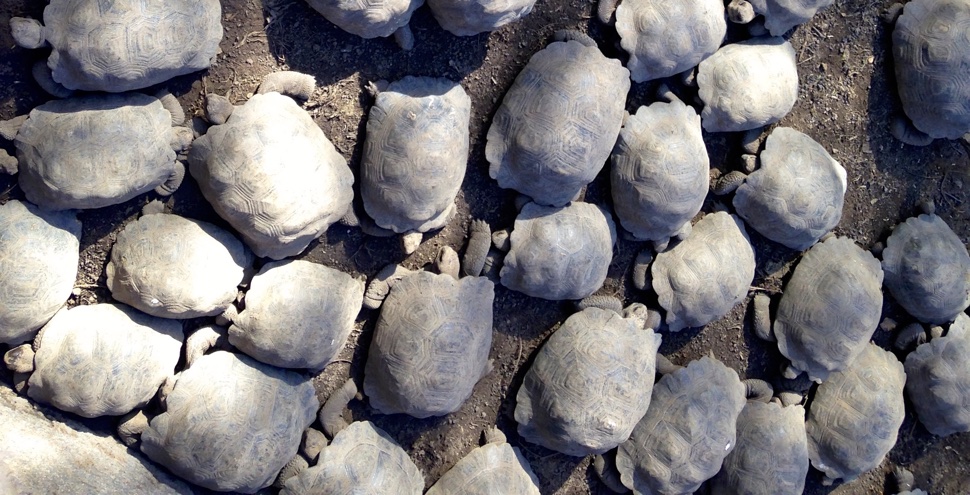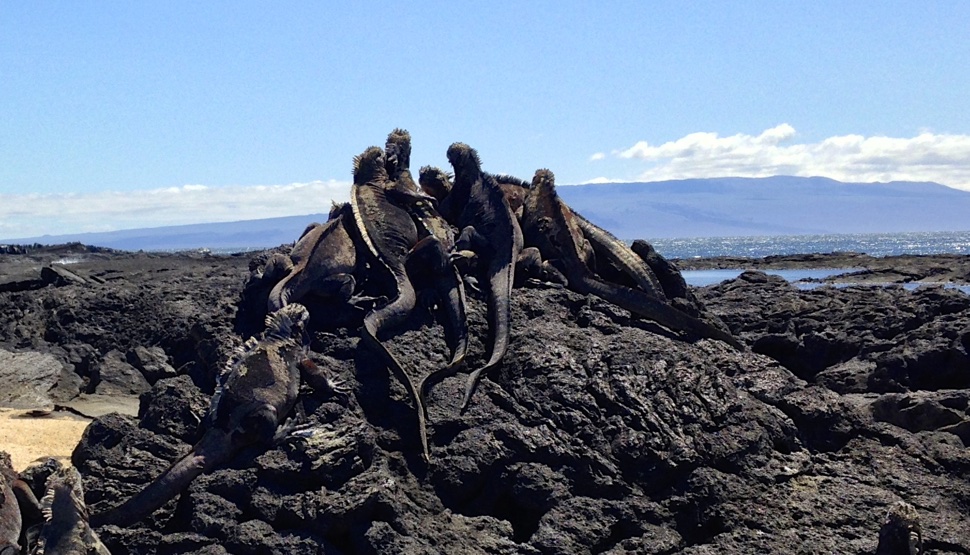
I went to the Galapagos in 2013. It was an amazing trip, but planning it was a little scary. I wanted to do it on the cheap, and that meant not reserving anything in advance and hoping that I'd be able to find whatever I needed (hotels, food, tours, fun) once I'd landed on the island. On my own. Where I didn't speak the language. And my smartphone would be starved of precious, life-giving Internet access.
It all turned out marvelously, so I'm writing this as encouragement for anyone who wants to visit the Galapagos, spend a not-huge amount of money, and accept some uncertainty in the itinerary. This post is heavy with logistics, but there'll be photos. Before you read this, look at some other Internet material to get a grounding in the Galapagean basics. Done that? Good.
The impetus for the trip was my friend Ken, who found some amazing airfares to the islands and posted them to Facebook. $650 round-trip from SFO via Miami and Guayaquil, for travel in October. October/November is low season, but airfares for that period are still around $1500 right now. So, keep an eye out for dips in price, because airfare is the priciest part of the trip.

When you find a low fare, it will probably be during low season. Low season is fine. Ecuador is on the equator -- the weather is lovely no matter when you go, and once you get there, everything is less crowded and cheaper because demand is not as high.
I booked two other things beforehand: a night in a hotel in Guayaquil, where I had a stopover, and my first night on Santa Cruz Island in the Galapagos. What you're supposed to do is book a cruise in advance, and maybe that cruise will be part of a package that includes airfare and hotels and such. Other people recommend travelling to mainland Ecuador and booking the tour from there. My flight plan gave me no time on the Ecuador mainland, so I decided to not book a cruise until I got to the islands. That basically entails walking around town asking travel agencies about vacancies on cruises that are about to leave. They'll cut you a deal because a cut-rate customer is better than an empty space on board.
To be clear, you pretty much have to book a cruise. You'll miss a lot if you do the backpacker island-hopping thing for your entire trip. Most of the islands are only open to cruise boats. On the other hand, a "cruise" in the Galapagos is not an enormous smiling dystopia on the water; it's a small-to-medium sized boat that houses maybe 25 passengers at most.
I didn't know how long it'd take for me to find a cruise, so I got a hotel for the first night and figured I could improvise something for subsequent nights if no cruise panned out. I also booked a long trip -- two weeks -- thinking that would give me maximum flexibility. My thinking was: it would suck to be there for a week, but only find a week-long cruise two days into the trip and not be able to take it.
It's a good idea to learn Spanish. I wish I had. Most Galapagos natives don't speak English, so non-Spanish-speaking travellers rely on a mix of charades, fellow travellers who did their homework, and the uncanny cross-cultural telepathy that sometimes manifests when it is badly needed.
An hour after my plane landed on Santa Cruz, I found a cruise. A bus drove us from the airport to the center of town. While I was walking to my hotel, I passed a travel agency, and a guy stuck his head out and told me he had a great deal for me on a cruise that was leaving in two hours. The deal: $1100 for a 6-night cruise on the Galapagos Oddysey, one of the nicer boats. The travel agent told me it was a great boat, a great deal, etc. I ran to an Internet cafe a block away to verify that this was a real boat that people liked. It checked out, so I plunked my money down. The agent's wife whisked me out to the boat via water taxi. I did as much due diligence as I could, but the whole process was anxiety-inducing for a cynical city boy like myself. After all, what kind of rube gets lured into an travel agency by a "hey you" sales pitch on the street and plunks down a bunch of cash for a trip on a boat he's never heard of? This guy, right here.

Aside from forfeiting a night in the hotel I booked, the situation couldn't have turned out better. It was a great price for a spot on a great boat that slept 16 paying passengers, but there were only 14 of us, so me and the only other single person on board got our own rooms. The timing was such that, when the cruise was over, I'd have an unbroken week leftover to bum around on the beach before flying out. The people on the boat -- staff and passengers alike -- were friendly, funny and interesting. Our naturalist guide (there's one on every boat) was named Fabricio and he was amazing. The boat went to Isabela, Ferdinandina, Santiago and San Cristobal. Don't think too much about which islands to go to. You can't see them all, and they all have different experiences to enjoy. I was not the only passenger who booked a last-minute berth. Some passengers paid a little more than my $1100, some paid a little less. There was a group of Germans, however, who booked from Germany for $3000, and they were not happy when they found out how much we paid.
So I got lucky with my trip. If I had been less lucky, maybe I'd have had to share a room, or maybe I wouldn't have found a cruise right away and would have had to shop around in Puerto Ayora for a bit.

After the cruise dropped me off in San Cristobal, I had a week to kill on my own. I ended up backpacking around San Cristobal and Santa Cruz with friends I met on the cruise. One by one, they went back to the mainland, but by the time they were all gone I'd befriended other hostel guests to explore with.
A week of backpacking was too much time. There was not much left to see by the end of the trip, so there was a lot of beach time during those last few days, with sea lions, iguanas and manta rays to keep me company. The ideal amount of time to spend in the Galapagos is about 12 days. That's enough time to find a week-long cruise, even if you don't find it on the first day, while also allowing for a few days to soak up the day-to-day atmosphere.

While backpacking, I recommend:
- Drinking beer on the Puerto Ayora harbor at night with new friends and watching the sea lions, sharks, turtles and rays off the pier.
- The Casa de Laura hostel in San Cristobal. So I was chilling in a hammock in the hostel when the eponymous Laura comes out and asks me, in Spanish, if I need directions to the hostel. Which was confusing. Turns out she was actually asking me for a favor: an English-speaking person needed directions from the airport to the hostel, and could I type up the directions in an email? It took 30 minutes for this idea to be communicated. As frustrating as my monolinguality was, I had a lot of fun with these kinds of interactions, and what I liked about Laura was that she seemed to enjoy them too. It was nice to feel useful with my English.
- La Casa de Piedra (Lava House) hostel in Puerto Ayora. This was the hostel I skipped out on when I booked the cruise. I went back to it when I returned to Puerto Ayora and told the warm, funny woman who runs the place that I had a prepaid reservation before that I had to skip, and is there any way I could use that reservation now, and tack on a few more nights? She agreed. Again, this complicated conversation took about an hour, but neither of us was in a rush.
- Guanabana! The fruit that's as fun to pronounce as it is delicious! Try it in a smoothie.
I don't recommend:
- Ceviche. My quest for ceviche turned into a farce: I found at least three "cevicherias", but none of them were ever open. Another place was all out. Another place, it was way too expensive. When I finally found it, it was disappointing. Don't pin too many hopes on food (the exception being pescado enconcado, which is delish).
- Hostel Leon Dormido on San Cristobal. It's nice enough, but noisy, and there are better places to stay.
Other notes:
- Total trip cost including airfare, cruise, room, board and the $100 entrance fee: around $2500.
- This post is about logistics, but every waking hour was some kind of wildlife magic.
- Okay, another story: every night, the cooks would throw food waste into the sea from a hatch near the ship's water line. When the hatch opens, sea lions and pelicans congregate nearby to get the scraps as they're tossed out. The sea lions loved chasing flashlights, so we'd run around the boat shining our lights into the water, and once the sea lions were in the spotlight they'd swim in circles or chase each other.
- I used these wristbands to ward off seasickness, and lo: though I took no dramamine, I never got seasick. On one hand, I usually do get seasick, so I was impressed. On the other hand, it may just be chance or the placebo effect or maybe I don't get seasick anymore. YMMV.
Thanks for reading!
